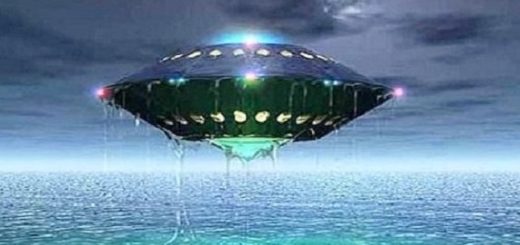Space Alien Encounter Scenario Has Scientists Saying How We Will React

It is conceivable that humans could someday discover aliens. We scour the cosmos looking for their radio signals, and though we’re not capable of interstellar space travel, it is remotely possible that we could find what we’re looking for right here in our solar system.
Life could theoretically exist on Mars, or on Europa, a moon of Jupiter, which appears to have an underground ocean. It’s even possible (though highly unlikely) that these nearby life forms could be sentient. “It is consistent with current human exploration of the solar system that intelligent beings could have evolved in the deep oceans of Europa,” said Jacob Haqq-Misra, an astronomer at Pennsylvania State University.
Another possibility, Haqq-Misra said, is that “intelligent extraterrestrial beings have traveled from a distant star system and taken up residence in the solar system. They might be living in an underground base on Mars or the moon, or they could be residing in the asteroid belt (or any number of other plausible, albeit unlikely, options).”
Considering these scenarios, what would we do if we encountered an alien race? As it turns out, the question has garnered considerable academic thought since the first reported flying saucer sighting in 1947, not just as an inquiry in human psychology, but also as a way of contemplating what aliens might do if they ever found us. From astronomers to ufologists to anthropologists, scholars who have contemplated the various “contact scenarios” believe our course of action would strongly depend on the relative intelligence level of the newfound beings. Here, we outline what would happen if we encountered primitive, humanlike, and godlike aliens.
Voyage of discovery
According to Seth Shostak, senior astronomer at the SETI Institute in Mountain View, Calif., the most likely contact scenario is that the alien race we discover will be extremely primitive. This assumption is based on reality, given that the habitable worlds we’re capable of exploring — such as Mars and Europa — show no signs of harboring advanced beings. But it also makes sense philosophically: Judging by how long inhabitants of Earth spent in the insectlike trilobite stage compared with how long humans have been around, there’s a better chance that life found anywhere in the universe will be primitive.
Furthermore, in light of the immense difficulty of space exploration, it is thought that explorers will typically be far more advanced than the creatures they discover. This makes it easy to set the protocol for a first encounter: If we landed on Mars or Europa and discovered the alien equivalents of trilobites, “you would do what Darwin did — collect samples and take them back home,” Shostak told Life’s Little Mysteries.
Seven steps
Despite the tendency of Hollywood films and sci-fi novels to depict malevolent encounters between evenly matched space adversaries, Shostak says the size of the universe and the rarity of life makes it extremely unlikely that two races of roughly equal intelligence will encounter one another in the cosmos. That said, reports of UFO sightings led some scholars to develop theories about this scenario. They asked: what would we do if we were aliens discovering us? [Science Fact or Fiction: ET Will Look Like Us]
According to Robert Freitas, author of several books outlining possible alien contact scenarios, in 1950 the U.S. military developed a procedure called “Seven Steps to Contact,” laying out the logical steps we would take upon discovering creatures with roughly human-level sentience. According to the steps, we would begin with remote surveillance and data gathering, and would eventually move on to covert visitations with the goal of gauging the performance characteristics of the aliens’ vehicles and weaponry.
If we judged our technological capabilities to be superior to those of the other race, we would attempt near approaches to the planet to determine whether the alien beings were hostile, and if so, by what means. If all went well, we would then make brief touchdowns in isolated areas, securing specimens of plants, animals, and of the intelligent beings themselves. In other words, this phase would involve non-harmful abductions similar to those reported by some Americans. (Interestingly, the “Seven Steps to Contact” plan predated the first reported alien abduction incident in 1957, suggesting the theory could have influenced such reports.) [Alien Abductions May Be Vivid Dreams, Study Finds]
Next, we would make our presence known, making low-level approaches where our craft and its operators could be seen, but not reached. We would try to be witnessed by the greatest possible number of inhabitants, and would demonstrate our existence and our nonhostile nature. Lastly, if all went well and there was no reason to think that contact would be disastrous for the two races involved, we would land and attempt to communicate face-to-alien-face.
Half a century since that military report was penned, we’d still follow much the same procedure. “Let’s say that a near-future mission to Europa reveals indisputable evidence of intelligent beings/civilization, Haqq-Misra said. “Continued remote exploration would probably be the most likely progression, with attempts at remote communication with the subterranean intelligent beings included as part of the missions. Eventually humans would want to land and make contact (wearing astro-scuba suits?), but a ‘precautionary principle’ might delay human exploration until robotic exploration has confirmed that Europa’s inhabitants are safe.”
Alien overlords
What if, as in the second scenario proposed by Haqq-Misra, we happened upon a race of aliens who were orders of magnitude smarter than us — beings capable of interstellar spaceflight who had established a base somewhere in our solar system? Just as ants can’t make sense of human behavior, it’s difficult or impossible for us to understand how this advanced race would react to us. “[The renowned astronomer] Carl Sagan figured any aliens that might be able to travel between the stars would be so advanced that they would be beyond all this business of aggression and war and so forth,” Shostak said. “But that may just be a projection of what he hopes humans would do eventually.”
Shostak tends to think differently. Aggression, he says, evolved as a trait among Earthlings because it helps us obtain and protect resources. Though aliens would probably have evolved under totally different conditions, pressure to secure finite resources would probably have molded their behavior, too. “I suspect resources would be finite anywhere in the universe.”
If Sagan is right, then the wise race we encountered would treat us with immense consideration and respect, while having the technology to ensure that we treat them similarly. If Shostak is right, and the incredibly advanced aliens we stumbled upon were also as aggressive as we are, we’d probably be toast.
By: Natalie Wolchover Published: 03/29/2012 01:41 PM EDT on Lifes Little Mysteries
Well, not toast exactly. In Haqq-Misra’s opinion, “A society capable of interstellar travel should have solved their development issues such that they do not need humans for food.”
Follow Natalie Wolchover on Twitter @nattyover. Follow Life’s Little Mysteries on Twitter @llmysteries, then join us on Facebook.
7 Things Most Often Mistaken for UFOs A Field Guide to Alien Planets Are We Alone In the Universe? New Analysis Says Maybe
Copyright 2012 Lifes Little Mysteries, a TechMediaNetwork company. All rights reserved. This material may not be published, broadcast, rewritten or redistributed.



 Creators of mankind
Creators of mankind Description of “Tall white aliens”
Description of “Tall white aliens” Where they came from?
Where they came from? About hostile civilizations
About hostile civilizations The war for the Earth
The war for the Earth “Tall white aliens” about eternal life
“Tall white aliens” about eternal life Video: “Nordic aliens”
Video: “Nordic aliens” Aliens
Aliens Alien encounters
Alien encounters The aliens base
The aliens base UFO
UFO Technology UFO
Technology UFO Underground civilization
Underground civilization Ancient alien artifacts
Ancient alien artifacts Military and UFO
Military and UFO Mysteries and hypotheses
Mysteries and hypotheses Scientific facts
Scientific facts


















